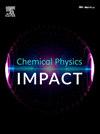Green synthesis of rGO/MgO nanocomposite using Hylocereus polyrhizuspeel extract for antibacterial activity and photocatalytic dye degradation study
IF 4.3
Q2 CHEMISTRY, PHYSICAL
引用次数: 0
Abstract
Current study demonstrates the preparation of rGO/MgO nanocomposite using Hylocereus polyrhizus due to its functional benefits, and green strategy method. Scanning electron microscopy (SEM) with Energy Dispersive X-ray analysis and X-ray diffraction were used to find the presence of crystal structure and the elemental analysis. XRD results revealed the cubic structure of the synthesized nanocomposite. The average crystallite size was 36.16 nm. The SEM portrays the agglomerated granular structure has larger scale web like structure are highly interconnected with large voids. The presence of graphene, magnesium and oxygen were analysed from the EDAX elemental studies. The presence of MgO and rGO diffraction planes is well matches with JCPDS card no. 04-0829 and 75-2078. Mg–O–C stretching vibrations and C–O stretching vibrations reflected from FTIR studies confirms the presence of Mg and C in prepared composite. Furthermore, the photocatalytic capability of green synthesized rGO/MgO nanocomposite were employed to investigate the Methylene Blue degradation under solar irradiation when exposed to sunlight for 90 min, about 93 % of the dye was degraded. Disc diffusion method was performed to test the antibacterial activity against S. aureus and Escherichia coli at higher concentration of nanocomposite reveals that S. aureus showed maximum zone of inhibition. rGO/MgO material in terms of bioremediation of domestic and industrial waste by killing pathogenic bacteria, breaking down of colourant. The rGO/MgO nanocomposite's promise in environmental remediation is demonstrated by these results, especially in wastewater treatment for dye degradation and harmful bacteria suppression.

利用多根茎皮提取物合成绿色氧化石墨烯/氧化镁纳米复合材料,进行抗菌活性和光催化染料降解研究
目前的研究主要是利用多根水蛭的功能优势和绿色策略方法制备氧化石墨烯/氧化镁纳米复合材料。利用扫描电子显微镜(SEM)、能量色散x射线分析和x射线衍射分析发现了晶体结构的存在并进行了元素分析。XRD结果显示合成的纳米复合材料具有立方结构。平均晶粒尺寸为36.16 nm。扫描电镜分析表明,颗粒状结构具有较大的规模,网状结构与大空隙紧密相连。从EDAX元素研究中分析了石墨烯、镁和氧的存在。MgO和rGO衍射面的存在与JCPDS卡号吻合较好。04-0829和75-2078。FTIR研究反映的Mg - o - C拉伸振动和C - o拉伸振动证实了制备的复合材料中Mg和C的存在。此外,利用绿色合成的rGO/MgO纳米复合材料的光催化性能,研究了其在太阳照射下对亚甲基蓝的降解,当太阳光照射90 min时,约93%的染料被降解。采用圆盘扩散法检测纳米复合材料在较高浓度下对金黄色葡萄球菌和大肠杆菌的抑菌活性,结果表明纳米复合材料对金黄色葡萄球菌的抑制作用最大。还原氧化石墨烯/氧化石墨烯材料在生物修复方面的家庭和工业废物通过杀死致病菌,分解着色剂。这些结果证明了还原氧化石墨烯/氧化石墨烯纳米复合材料在环境修复方面的前景,特别是在染料降解和有害细菌抑制的废水处理方面。
本文章由计算机程序翻译,如有差异,请以英文原文为准。
求助全文
约1分钟内获得全文
求助全文
来源期刊

Chemical Physics Impact
Materials Science-Materials Science (miscellaneous)
CiteScore
2.60
自引率
0.00%
发文量
65
审稿时长
46 days
 求助内容:
求助内容: 应助结果提醒方式:
应助结果提醒方式:


